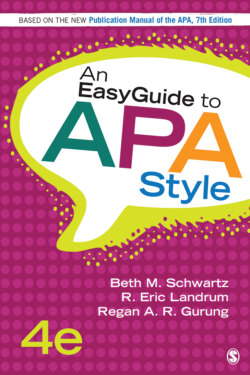Читать книгу An EasyGuide to APA Style - Regan A. R. Gurung - Страница 23
На сайте Литреса книга снята с продажи.
Active Voice Versus Passive Voice in APA Style
ОглавлениеFor many native English speakers, subject–verb agreement is only an occasional problem, and if we practice and attend to the rules, these types of errors can be minimized or eliminated. However, depending on your prior writing experience, slipping into passive voice can be natural. Additionally, some students think that passive voice is more “scientific sounding” and makes the text seem more detached and objective, as scientific writing often strives to be. Unfortunately, passive voice makes writing more muddled, often placing the subject of the sentence after the verb. We generally prefer—and understand better—when we follow the subject–verb–object pattern in a sentence. Clarity is key, and writing in active voice typically provides the best shot at clear communications.
What is the difference between “active voice” and “passive voice”? The structure of an active-voice sentence tends to follow the pattern, performer (subject) → verb → receiver (object). The active voice indicates stronger writing because the sentence gives credit to who is performing the action; in other words, the active voice focuses on the performer of the action. Active voice is an indicator of clear and vigorous writing and is preferred in most academic writing (BioMedical Editor, 2009; DailyWritingTips.com, n.d.; Knight & Ingersoll, 1996; PlainLanguage.gov, n.d.). Active voice is typically clearer because the person performing the action is made clear.
Using passive voice (in which the pattern is receiver → verb → performer, with the performer often not named) is sometimes a difficult habit to break for some educators, because the tradition at one time preferred a passive-voice–third-person approach because it implied a sense of detachment and objectivity (BioMedical Editor, 2009; Knight & Ingersoll, 1996). A sentence written in passive voice emphasizes the receiver of the action and not the subject performing the action. Unfortunately, passive voice often adds confusion to the sentence, particularly the subject of the sentence. This is not to say that the use of passive voice is evil but that the use of passive voice is not preferred in APA-Style writing.
Here are some examples of active-voice sentences:
My students completed the survey before the time elapsed.
I analyzed possible sex differences using an independent-means t test.
We recruited students from introductory psychology to participate in this research project.
I prefer using Word on Windows rather than on a Mac.
As you can see, all these sentences are straightforward and relatively easy to understand. Consider these passive sentences and their active counterparts (PlainLanguage.gov, n.d.):
Passive: My car was driven to work. Active: I drove my car to work.
Passive: Breakfast was eaten by me this morning. Active: I ate breakfast this morning.
And here’s another:
Passive: The survey was conducted by me. Active: I conducted the survey.
It may seem absurd that anyone would purposely use passive voice, but writers (often new to scientific writing) slip into passive voice by accident (and there are times when passive voice is preferred; see the following examples). Knight and Ingersoll (1996) expressed slightly stronger opinions about using passive voice, calling it “dry, dull, rigid, pompous, ambiguous, weak, evasive, convoluting, tentative, timid, sluggish, amateurish” (p. 212)—you get the picture. Notice how easily you can slip into passive voice by accident:
The data were analyzed using SPSS. (The subject is not named: Who used SPSS to analyze the data?) Better to say, “I analyzed the data using SPSS.”
This conclusion was reached by the researchers in the study. (Notice the pattern: The object—“conclusion”—precedes the verb, and the subject—“researchers”—follows the verb.) Better to say, “We reached the following conclusions….”
Although manic depression was identified in some of the participants, the drug treatment was beneficial for all participants in the study. (The first part of the sentence—“manic depression was identified”—is passive; the second part—“drug treatment was beneficial”—is not passive, because the subject precedes the verb.) Better to start the sentence with “Although we identified manic depression symptoms in some of the participants, ….”
You can imagine reading each of these three sentences in a journal article, yet all three are written in passive voice. So when would you use passive voice? Passive voice is useful when you want to emphasize the receiver (or object) of the action (BioMedical Editor, 2009). That is, passive voice is appropriate when you are writing a sentence and you do not know the performer of the action, or when the performer of the action is unimportant (PlainLanguage.gov, n.d.). For instance, passive voice may be more appropriate when writing the Method section of a manuscript, because the Method section is likely to focus on objects such as materials and procedures (APA, 2020).
An excellent tip to help you find possible instances of your inadvertent use of passive voice is to check your file for some form of the verb “to be”—including “is,” “are,” “was,” or “were” (DailyWritingTips.com, n.d.; Knight & Ingersoll, 1996). Notice in the examples, the “to be” verb is included with an additional verb in each passive-voice sentence but not in the active-voice sentences. Before you hand in a paper, you might use your Find feature in Word 2016 found to the far right under the Home tab. You can also just press Ctrl+F to get the Navigation box that allows you to type in a word to find throughout your document. You can then find all occurrences of “is,” “are,” “was,” and “were” to check for passive-voice sentences, keeping in mind that passive voice includes these “to be” verbs with another verb that follows (e.g., “surveys were collected by the research assistants”).
